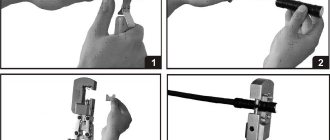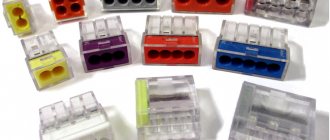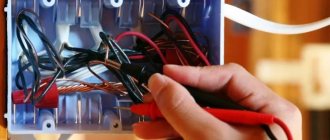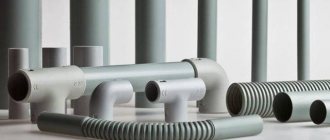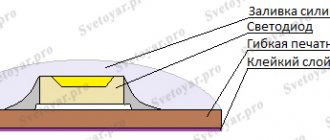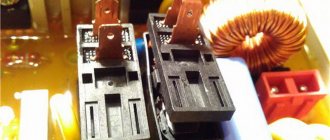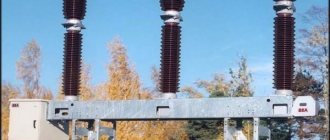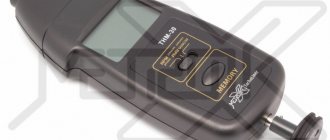Advantages and disadvantages
There are many positive aspects to crimping:
- The tool used to make this connection is hand-held and does not require electricity to operate. In cases where you have to work in a room where there is no voltage, crimping is the only high-quality connection method.
- Using crimping tubes, you can connect conductors from different metals, which is a solution to the eternal problem of switching copper and aluminum conductors in one electrical unit.
- If welding requires a specialist capable of performing welding work, and when soldering it is necessary to be able to use a soldering iron, then anyone can do crimping; you just need to try the press pliers in action once.
- Using a special crimping tool, it is possible to make connections in any, even limited spaces. It is especially convenient when connecting wires in a socket box or box.
- Crimping with press pliers and sleeves allows you to shorten the connected sections of wires to a minimum.
- Due to mechanical force, the most durable contact connection is created.
- As a result of crimping, a permanent connection is obtained that can withstand heavy physical stress when breaking.
- Installation speed is minimal, connection quality is maximum.
- This contact does not require any maintenance.
The one-piece type of crimping is in some way a disadvantage, that is, if necessary, it is impossible to unscrew the connection and replace one of the conductors. The sleeve can only be cut out.
Tools and materials
To work, you will need manual (or mechanical) press pliers. They crimp a sleeve with conductors with a cross section of up to 120 mm2. For conductors with a larger cross-section, a press is required, which is driven by a hydraulic drive.
There are pliers with dies for different sections and with adjustment of the punches. A very convenient tool in the sense that you don’t have to constantly reset it to other sizes, just turn the punch screw or matrix to the desired section.
When working with aluminum wires, you will need a special quartz-vaseline paste, which removes the oxide film on the wires and prevents its reappearance.
Copper conductors do not need such treatment, but it is still advisable to lubricate them with ordinary technical petroleum jelly to reduce friction. During deformation, the cores can be damaged, and lubricant minimizes this risk.
It is very important to choose the right sleeves for crimping wires
According to the material of execution
A copper cable or wire should be crimped with copper sleeves accordingly. They come in two types and have the following abbreviation:
- GM - copper sleeves. They are made purely of copper, do not have any coating or processing, and in appearance they look like ordinary pieces of copper pipes.
- GML – tinned copper sleeves. They undergo a tinning procedure, that is, their surface is treated with a special tin-bismuth layer. This is done in order to prevent oxidation and corrosion processes. It is also known from school physics lessons that copper, like any other metal, oxidizes. Tinning prevents this process; the crimped wires will not enter into a chemical reaction with the tinned sleeve.
I would like to give one useful piece of advice. Do not listen if suddenly one of the experienced electricians tries to prove to you that using GML sleeves it is possible to crimp aluminum wires, since the tin layer will not allow direct contact of aluminum with copper. This is incorrect, because during crimping the surface layer of the tube is deformed and the corrosion process is still inevitable.
To connect aluminum wires, they use products made of the same metal; they are designated GA (aluminum sleeve).
There are also combined sleeves, they are designated GAM (aluminum-copper sleeve), in everyday life many call them aluminum-copper. This option is used when you need to connect wires made of different metals end to end. The sleeve is a tube of two parts; at the junction of dissimilar metals, the connection is made by friction welding. Here everything is extremely simple and clear - you need to insert copper wires into the part of the tube made of copper, and an aluminum conductor into the aluminum part.
And the most modern version with the designation GSI (insulated connecting sleeves). They are based on ordinary tinned tubes, only they are covered with polyvinyl chloride insulation on top. They crimp copper wires. During crimping, the insulating layer is not removed, pliers are put on top of it, and compression is performed. Such sleeves greatly simplify the work of an electrician, since the crimped electrical assembly no longer requires any additional measures to insulate it.
By size
After the letter designations, a number is written on the sleeve. What does it mean? This is the cross-section of the conductor for which this product is designed. For example, tinned copper sleeves are produced for wires with a cross-section from 2.5 to 300 mm2. Accordingly, with an increase in the cross-section of the conductor, the sleeve itself has larger dimensions (diameter and length). For combined products, two numbers are written through the fraction, one indicates the cross-section of the copper conductor, the second - the aluminum.
By design
The sleeves also differ in design. They can be hollow, that is, inside they are bare through tubes. And they come with a partition in the middle, which allows you to adjust the depth of the conductors, that is, the tips of both connected wires will enter the sleeve to the same length. Combined sleeves are produced with partitions, which are used when connecting conductors at the joint.
Dimensions and design features
We've sorted out the type of sleeves, now let's look at the standard sizes and range of sections. The minimum cross-section that I found on the Internet is 1.5 mm2 (this is for GML). Then everything goes in increasing order: 2.5 mm2, 4 mm2, 6 mm2, 10 mm2, etc. In general, sleeves are made with a cross-section equal to the standard wire cross-section.
How to read the transcript? For example GML-6 “tinned copper sleeve with a cross-section of 6 mm2”. For GAM sleeves, two numbers are written through a fraction - the cross-section for aluminum and the cross-section for copper. For example, GAM 16/10, 16 is the cross-section of the aluminum part (in mm2), 10 is the cross-section of the copper part (in mm2).
By design, the sleeves are either through (a bare tube inside) or with a partition (used to connect two wires end-to-end).
Partitions are located in the middle. Thanks to these partitions, the depth of the cable entry is adjusted, that is, when extending, both ends of the cable will enter the sleeve to an equal length. Such sleeves are used to connect (extend) wires end to end.
Let's try to extend the wire using GSI-6. I will use the wire PV-3, 6 mm2, that is, the cross-section of the sleeve corresponds to the cross-section of the wire. We remove the outer insulation from the wire, insert one end into the sleeve and crimp it. For crimping we use proven press pliers PK-16 with the appropriate size of the working area of the jaws (6 mm).
We do the press on top of the insulating layer. We do the same with the other end of the wire, remove the insulation, insert it into the sleeve, and press it. Insulated sleeves for crimping wires are covered with PVC insulation and are very convenient in this regard. After crimping, they do not need to be insulated. If you extend wires using ordinary non-insulated sleeves, then for insulation you can use heat-shrinkable tubing HERE. I already wrote about how to use such tubes on the website electricvdome.ru, please come in, everyone can read it and ask a question.
Sleeves for crimping wires: important points!
When creating electrical networks, connecting socket blocks, and expanding wiring, the task of connecting cables to each other arises. The resulting contacts must be strong and insulated. In domestic conditions, the best solution to the problem is sleeves for crimping wires. These are small tubes into which the cables are inserted and then clamped. This results in a strong permanent connection that ensures normal contact between all cores. Wire crimp sleeves are not the only connection option. But other methods have certain disadvantages:
- Stranding the cores is the simplest option. The wires are stripped and twisted together, after which they are rewound with electrical tape. During this process, the surface tension of the metal is weakened, microcracks are created, and the cores are not completely adjacent to each other. As a result, the connection is of poor quality. No electrician twists wires.
- Use of connecting insulating clamps (PPE). Special caps are easy to use; they are often used when installing socket blocks and for connecting wires in junction boxes. But the connection in plastic products is not as strong as when using other methods. Therefore, PPE is used only in simple cases.
- The use of terminal connectors is not recommended for high current applications. They are suitable for connecting a cable to a new light bulb, but to expand the network and make, for example, an outlet for a washing machine, the products are unsuitable.
- Soldering the cores ensures good contact. But under high loads there is a possibility of solder overheating, increasing resistance, and further heating until contact is lost. Soldering is inconvenient if there is not enough space.
- Welding is the most reliable method available. During the work, not just a connection is formed, but a monolithic wire. But you need to have special equipment and skills to operate the device.
Sleeves for connecting wires are free from all the described disadvantages
The task will not require electricity, which is especially important when creating a new network. In addition to the sleeves for crimping, you will need crimping pliers
Their cost ranges from 7 to 40 dollars. The cheapest options are suitable for home use. The pliers are compact; the parts that perform direct crimping are placed in small distribution boxes and socket boxes. Learning how to use a crimping tool correctly takes a few hours and a couple of broken pieces of wire.
The process of crimping with sleeves
Crimping should be understood as a simple operation of connecting wires using special sleeves - tubes made of different types of metal. In this case, the sleeves play an important role as a connecting mechanism. The wires are placed into the body of the sleeve, after which the tube is crimped using a special tool. The result is a reliable and secure connection.
Compress the connecting sleeves in several places using heat shrink tubing or PVC tape for insulation. In some cases, it becomes appropriate to use insulated sleeves, which are discussed in more detail below.
Crimping of wires using metal tubes is advisable in cases where:
- It is necessary to connect the wires in areas with high load levels.
- If wires with a large cross-section need to be connected.
- It is impossible to use alternative connection options (at a height, in the absence of the required visibility, inside a junction box, etc.).
The crimping process has several positive aspects:
- The connection can be made without connecting to the mains using press jaws.
- The work does not require special skills or experience; anyone can handle it with their own hands, provided they have even the most primitive set of tools.
- You can work with a crimping tool in confined spaces with the ability to shorten wires to a minimum to increase installation density.
In addition, it is worth noting that crimping does not impose restrictions on the types of wires that must be connected, unlike welding.
How to connect SIP wires to each other
If you need to connect a SIP to a SIP, first find out its brand.
This is done only on some support, when there is no gravitational force on the cores. Some, however, believe that if the connections are made with sleeves and compressed with a 12-ton press, then it will easily withstand everything throughout its entire service life.
Of course, this connection will work for some time, but due to constant vibrations, wind loads, plus tension in different directions, one fine day everything will end in an ordinary break.
If you have SIP-1 or SIP-2, they can be connected to each other in spans using special MJPT or GSI-F clamps.
Moreover, use these clamps for phase conductors. It is advisable to leave the supporting insulated or non-insulated wire in a self-supporting insulated wire in one piece, or connect it using another sleeve in the space between the anchor fastenings.Some videos demonstrate the connection of the neutral support wire with a sleeve in the middle of the span. This is not prohibited in the rules of the PUE clause 2.4.21. The main thing is to ensure the required load-bearing capacity of the wire.
To do this, take a sleeve of increased length, for a greater number of crimps (170 mm long instead of 100 mm). With the abbreviation “N” or “N” - zero.
But just think logically, what will happen to the voltage in the sockets when the zero contact disappears during the next wind in such a connection? And instead of 220V it will be 380V! And a simple break in the wire in the sleeve will seem like the least evil in this situation.
Differences in wire crimping tubes by material
Connecting sleeves are divided into several types depending on the material of manufacture. The use of different types is due to the fact that, due to the electrochemical properties of metals, some react actively with each other, which leads to oxidation of the wires and their overheating under load.
Copper sleeves
The abbreviation GM indicates that the sleeve is made of high-quality copper. Used exclusively for connecting copper wiring. The surface of the GM is not covered with a protective shell, so it can only be used in non-aggressive environmental conditions.
Tinned sleeves
Tinned sleeves are used to connect copper wires intended for use in aggressive environments. These are the same copper sleeves, only their surface is coated with a special compound that forms a white protective shell. The abbreviation is as follows - GML.
The advantage of tinning is to protect the material from electrochemical corrosion, however, it is prohibited to use GML for aluminum wiring. This is due to the fact that during the compression process the protective layer is partially destroyed, which will result in direct contact between aluminum and copper.
Connecting tubes for cores made of different materials
The installation of electrical lines, as a rule, is not complete without the use and connection of cores made of different materials. For such purposes, special sleeves are used, which are considered combined and are called GAM. The design is simple, but its peculiarity lies in the use of different materials. Two parts of the tube are welded into one, one is made of aluminum and the other of copper. The middle, the junction is equipped with a special limiter. Thanks to it, equal input of the cores is ensured on both sides.
This variety differs in shape. This can be explained by the fact that the aluminum part of the tube has a larger diameter due to the need for a larger cross-section of the conductor.
The algorithm for crimping GAM is similar to the previous methods.
Types of sleeves
It is very important to choose the right sleeves for crimping wires.
According to the material of execution
A copper cable or wire should be crimped with copper sleeves accordingly. They come in two types and have the following abbreviation:
- GM - copper sleeves. They are made purely of copper, do not have any coating or processing, and in appearance they look like ordinary pieces of copper pipes.
- GML – tinned copper sleeves. They undergo a tinning procedure, that is, their surface is treated with a special tin-bismuth layer. This is done in order to prevent oxidation and corrosion processes. It is also known from school physics lessons that copper, like any other metal, oxidizes. Tinning prevents this process; the crimped wires will not enter into a chemical reaction with the tinned sleeve.
Cutting the sleeve
When crimping copper wires or any other wires when there is a shortage of sleeves, many try to cut the tip into several parts. This is due to saving money. But such an action will only lead to increased resistance and heating. Also, the wire will not crimp well. The connection is made only with a tool designed for this purpose. Do not attempt to perform the task of crimping and crimping with hammers, pliers or any other tool. The element will not take the desired shape and will not secure the wire. This can damage the sleeve and cable.
Crimping is a reliable way to connect two wires or cores and get good contact. But it is necessary to use only devices intended for this purpose. As a result, you will receive a high-quality permanent connection that will not oxidize.
What does your nose shape say about your personality? Many experts believe that you can tell a lot about a person's personality by looking at their nose.
Therefore, when you first meet, pay attention to the stranger’s nose
11 Weird Signs That You're Good in Bed Do you also want to believe that you please your romantic partner in bed? At least you don't want to blush and apologize.
Unforgivable Movie Mistakes You Probably Never Noticed There are probably very few people who don't enjoy watching movies. However, even in the best cinema there are mistakes that the viewer can notice.
10 charming celebrity children who look completely different today Time flies, and one day little celebrities become adults who are no longer recognizable. Pretty boys and girls turn into...
9 Famous Women Who Have Fallen in Love with Women Showing interest in people other than the opposite sex is not unusual. You are unlikely to be able to surprise or shock anyone if you admit it.
These 10 little things a man always notices in a woman Do you think your man doesn’t understand anything about female psychology? This is wrong. Not a single little thing can be hidden from the gaze of a partner who loves you. And here are 10 things.
Recommendations for crimp testing
If difficulties arise in selecting a sleeve that is ideally suited for the wires in size, it is better to opt for a tube slightly larger than required. In this case, the void can be filled by cutting bare wire with a slightly shorter length than the sleeve. Compaction in this way will improve the quality of the crimp.
When isolating the joint, the connecting tape must extend beyond the edges of the sleeve by at least 10 mm. If multi-core wires are connected to each other or it is necessary to splice different numbers of them on both sides, then the correct solution would be insulated type connecting sleeves.
In conclusion, we note that crimping as a process is not difficult if you act consistently, use a special tool and suitable sleeves. One way or another, you need to remember that we are talking about a permanent connection, so you will need a wiring diagram. Having a plan at hand will help you avoid mistakes during the work.
Crimping tool
Previously, some inventors used traditional tools for crimping - a hammer, chisel or pliers. This is against all the rules, but such an action often helped out. Today, a tool of various modifications is offered, intended for professional and household use:
- hydraulic, mounting and crimping pliers of various modifications;
- hydraulic and mechanical press. They can be manual or powered.
The crimping tool has a matrix. This is a shaped element that compresses the sleeve under pressure. Pressure on the matrix is exerted by a movable mechanism - a punch. In order for the connection contact to be reliable, it is necessary to correctly select the replacement tool matrix and perform crimping under a certain pressure.
Carrying out a large volume of electrical installation work with different wire cross-sections requires frequent changes of the punch and die. Carrying a large number of replaceable elements with you is inconvenient and difficult for an electrician. For such purposes, there is a more convenient tool with one replaceable punch or rotary dies of different sizes. To make settings for certain connecting tubes, the die is simply turned to the other side and the required number of turns are made with the punch screw.
There is another, simpler, crimping tool without a die and punch. They compress the connecting tube with curly brackets.
Classification by material of manufacture
One of the main parameters, depending on which wire sleeves are divided into different types, is the material of their manufacture. The need to use dissimilar sleeves is determined by differences in the electrochemical properties of the connected wires made of different metals. So, if an inappropriate sleeve is chosen to connect wires made of a certain metal, the place of the formed contact will oxidize, which over time will lead to a decrease in its reliability in terms of electrical conductivity.
The main types of sleeves for crimping electrical wires, depending on the material from which such tubes are made, are:
- copper sleeves;
- tinned connecting sleeves;
- combined;
- isolated.
Copper
A copper sleeve, which is marked GM, is needed for crimping wires also made of copper. Taking into account the fact that the copper sleeve does not have a protective coating, it can only be used to connect wires operated in a non-aggressive environment. If you neglect this requirement, the copper sleeve will quickly oxidize and cease to perform its functions.
Copper cable sleeves must be made from copper tubes of grades M1 or M2
Tinned
To connect electrical wires operated in an aggressive environment, tinned copper sleeves for crimping are used, which are marked GML. In order to protect the main material of their manufacture - copper - from electrochemical corrosion, GML sleeves are coated with a special compound.
This is explained by the fact that part of the protective coating of such a tube is destroyed when it is compressed, which will lead to contact between aluminum and copper and, accordingly, to the development of electrochemical corrosion.
Connecting sleeves type GML, made of electrical copper with a tin-bismuth protective coating
Combined
Quite often, when installing electrical networks, it becomes necessary to connect wires whose cores are made of different metals. To solve such problems, combined type sleeves have been specially developed and are successfully used. The design feature of such crimp tubes, which are marked GAM, is that one half of them is an aluminum connecting sleeve, and the second is made of copper. At the junction of two such tubes, which are connected to each other by welding, there is a special limiter. It is necessary in order to prevent contact of two dissimilar wires inside the sleeve itself.
Adapter cable sleeve aluminum-copper 16/10 sq. mm
Another design feature of combined crimp tubes is that the part of them, which is the aluminum connecting sleeve, has a larger diameter than the tube intended for copper cables. This design feature is explained by the fact that aluminum, when compared with copper, has greater electrical resistance, therefore the wire made from it, which will be connected to the same electrical network with a copper conductor, must have a larger diameter.
The crimping itself using combined sleeve clamps is performed according to the same algorithm as the procedure with sleeves of any other type. However, it is necessary to carefully ensure that dissimilar wires are inserted into a tube of the appropriate metal.
Isolated
Among the crimping tubes used for crimping electrical wires, the category of insulated connecting sleeves is distinguished. The use of the latter eliminates the need to perform additional insulation of the contact area formed with their help. In terms of their design, insulated sleeves are the same tinned copper tubes, the outer surface of which is covered with an insulating layer of fairly durable and at the same time plastic PVC. Due to the mechanical properties of such a protective layer, sleeves of this type can be successfully crimped without compromising their original characteristics.
Fully insulated connection sleeves
Insulated sleeves for hermetically sealed connection of SIP wire cores
Procedure for crimping wires
Crimping of wires is performed in a certain order:
- The end of the conductor is cut with a cutter as accurately as possible. In this case, the sleeve will be put on easily, without jamming the individual wires.
- The wire itself is marked to the required length and partially exposed along the length of the sleeve. All operations must be performed very carefully so as not to damage the wiring. If damaged, the contact will deteriorate significantly and the effect of such a connection will be significantly reduced. It is forbidden to twist the wires before putting them on the sleeve, since the best crimping occurs when the wires are arranged in parallel, which increases their contact with each other. Twisted wires intersect, are pressed at the crimp points and become deformed.
- The sleeve is carefully placed on the exposed part of the conductor, and you can twist it a little.
- All that remains is to insert the sleeve into the appropriate clamp and crimp.
The use of sleeves is recommended in electrical equipment operating with high currents. In some cases, the cross-section of the wire does not allow the use of another type of connection. Sometimes there is simply no free space in the junction box, and the wires have to be connected outside of it. All these problems are easily solved by crimping with various types of sleeves.
Typical errors during the crimping process
Connections of aluminum lines are made with tin-plated products; tin plating does not ensure 100% exclusion of contact of the copper surface with the wire, especially when deformed during compression
This will reduce the reliability and service life of the contact under long-term high current loads; The ends of the cables are ground and inserted into a cylinder of smaller diameter, this reduces the design cross-section and increases the transition resistance, weakening the contact strength; Cut the connecting tube, making it shorter, this will lead to an increase in contact resistance and excessive heating, reducing strength. When using heat shrink material in the insulation process, pay attention to the shrinkage ratio. During heat treatment, the cambric is compressed not to zero diameter, but to a certain size depending on the properties of the material from which it is made
If these parameters are not taken into account, the insulation may not cover the contact surface. Manufacturers indicate a reduction ratio of 2:1 on their products, which means that after heating the diameter decreases by 2 times. The designation can be 10 mm/5mm or 10/5 – 10 indicates the Ø in mm. before heating, 5 after shrinking.
Heat shrink insulation
Table of interchangeable heat shrink tubes from different manufacturers
Crimping wires using sleeves
December 28, 2016
Now there is a huge amount of technology that allows you to quickly and reliably connect electrical wires and cables. Each method has both pros and cons. Wires and cables are connected by welding or soldering. You can use twisting or fasten the conductors with terminal blocks or PPE. All these methods are good and effective. But when you need to get a really high-quality connection, crimping the leads will help.
The result of this method is good contact, protected from oxidative processes and a particularly strong connection. The only negative is the inconsistency. It will no longer be possible to disconnect the two cables. You just have to cut it. Crimping of wires is carried out using special tips - sleeves. They can be purchased at any hardware store or market. The cost of these elements is about $1 per unit.
Cores are inserted into them. And the sleeve itself is then deformed using a hand press, due to which a reliable electrical connection is created.
Related Posts
- Repair of electrical equipment on ships - cable termination
- Connecting wires in a junction box: learning how to connect wires
- Overview of electrical wire connectors
- Crimping and termination of wire and cable cores
- How to connect copper and aluminum wire
- Wire cross-section for home wiring: how to calculate correctly
- Cable current cross-section
- Terminals or twisting: comparing the pros and cons
- Junction box
- Hidden electrical wiring in a frame house
- How to crimp a network cable without a tool (screwdriver)
- Terminal blocks wago
- Subtleties of crimping a heating system
- Using PVC wire according to the characteristics and description
- What color is phase and zero in electrical engineering?
- Pugnp and punp wires: characteristics, differences, prohibition of use
- Technical parameters and scope of application of heat-resistant wire RKGM
- PPE for an electrician: standards, frequency of inspection
- Pvs cable. pugsp, pugnp: alphanumeric marking and decoding
- How to move a socket with your own hands: advice from professionals, a guide to action and 110 photos of transfer options
- Wire pv-1: description and characteristics
- Wiring diagram and installation of electrical wiring in the kitchen
- Instructions for connecting a three-key switch with your own hands
- Junction box with terminals
- How to connect the wires to the lamp socket?
Read with this
- Repair of electrical equipment on ships - cable termination
- Connecting wires in a junction box: learning how to connect wires
- Overview of electrical wire connectors
- Crimping and termination of wire and cable cores
- How to connect copper and aluminum wire
- Wire cross-section for home wiring: how to calculate correctly
- Cable current cross-section
- Terminals or twisting: comparing the pros and cons
- Junction box
- Hidden electrical wiring in a frame house
Sleeves for connecting wires by crimping - electrician's advice - Electro Genius
In practice, several methods are used to connect electrical wires. They can be twisted, soldered, connected using electric welding or a special block equipped with bolted fastenings. Each method has its own pros and cons, which manifest themselves during operation of the line in operating mode.
For medium and high currents, the optimal way is to connect the wires by crimping with sleeves . This method achieves two important goals - the connection has excellent electrical contact and high mechanical strength.
Technologically, the method is very simple: the stripped ends of the wires to be connected are inserted into a special metal sleeve, and the sleeve is crimped using special tools.
To do this, you need manual or mechanical press pliers, which provide very tight crimping of the contacts along the entire length. Hand pliers are used for sleeves with a cross-section of up to 120 mm2.
Connections larger than this size require the use of a hydraulically driven tool.
If it is necessary to crimp a large number of sleeves of different sizes, you should choose pliers with an adjustable punch or rotary dies designed for different sections. For crimping small-diameter sleeves, pliers with shaped jaws, without dies and punches, are used.
In terms of mechanical strength, connecting wires by crimping exceeds all other methods, but it turns out to be non-separable. To disconnect the crimped wires, the switching section must be cut off. Both copper and aluminum wires of any cross-section are suitable for connecting wires by crimping.
Today I want to talk about such an interesting area as crimping single-core wires with sleeves and, as an example, consider crimping VVGng-3x2.5 sq. mm copper wires.
Crimping wires with sleeves
Electrical installation work, such as wiring, is a very important stage in building an electrical network. But during the work they have to be connected by several wires into one node. To spend a minimum of time with the best results, special technology is needed.
Otherwise, if there is poor contact and significant electrical loads in the connection, the conductors will begin to heat up, the insulation will deteriorate and, in the worst case scenario, a short circuit in the junction box. The most reliable and least troublesome technology in this case is the use of a sleeve for crimping wires. This will be discussed further.
Result of a bad connection in a junction box
